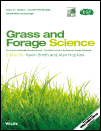View Item
- xmlui.general.dspace_homeCentros Regionales y EEAsCentro Regional Entre RíosEEA Concepción del UruguayArtículos científicosxmlui.ArtifactBrowser.ItemViewer.trail
- DSpace Home
- Centros Regionales y EEAs
- Centro Regional Entre Ríos
- EEA Concepción del Uruguay
- Artículos científicos
- View Item
Beneficial effects of Neotyphodium tembladerae and Neotyphodium pampeanum on a wild forage grass
Abstract
Asexual, vertically transmitted fungal endophytes of the genus Neotyphodium are considered to enhance growth, stress resistance and competitiveness of agronomic grasses, but have been suggested to have neutral or deleterious effects on wild grasses. We studied whether the associations between Bromus auleticus and their endophytes, Neotyphodium pampeanum and Neotyphodium tembladerae, are beneficial for this wild forage grass native to South America. In a
[ver mas...]
Asexual, vertically transmitted fungal endophytes of the genus Neotyphodium are considered to enhance growth, stress resistance and competitiveness of agronomic grasses, but have been suggested to have neutral or deleterious effects on wild grasses. We studied whether the associations between Bromus auleticus and their endophytes, Neotyphodium pampeanum and Neotyphodium tembladerae, are beneficial for this wild forage grass native to South America. In a greenhouse experiment, 3‐month‐old endophyte‐infected plants (E+) showed enhanced growth relative to their endophyte‐free counterparts (E−). In a one‐year‐long experiment in the field, E+ plants showed higher survival and regrowth rate, and produced more biomass and seeds than E− plants. Only with respect to the seed output did N. tembladerae seem to be detrimental, whereas N. pampeanum did not affect this parameter. No differences were observed with respect to the germination of seeds produced by E+ or E− plants. Loline alkaloids were detected in N. pampeanum‐infected plants. Our results show that, similar to results with agronomic grasses, in wild grasses, the symbiosis with Neotyphodium species could be mutualistic.
[Cerrar]

Author
Iannone, Leopoldo Javier;
Pinget, Albertina Daniela;
Nagabhyru, P.;
Schardl, Christopher L.;
De Battista, Jose Pedro;
Fuente
Grass and Forage Science 67 (3) : 382-390 (September 2012)
Date
2012-09
Editorial
Wiley
ISSN
0142-5242
1365-2494
1365-2494
Formato
pdf
Tipo de documento
artículo
Palabras Claves
Derechos de acceso
Restringido
 Excepto donde se diga explicitamente, este item se publica bajo la siguiente descripción: Creative Commons Attribution-NonCommercial-ShareAlike 2.5 Unported (CC BY-NC-SA 2.5)
Excepto donde se diga explicitamente, este item se publica bajo la siguiente descripción: Creative Commons Attribution-NonCommercial-ShareAlike 2.5 Unported (CC BY-NC-SA 2.5)

